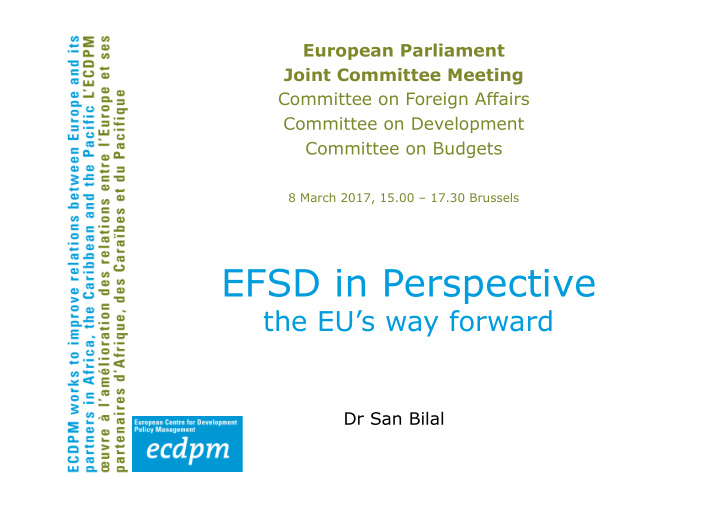



European Parliament Joint Committee Meeting Committee on Foreign Affairs Committee on Development Committee on Budgets 8 March 2017, 15.00 – 17.30 Brussels EFSD in Perspective the EU’s way forward Dr San Bilal
EFSD (European Fund for Sustainable Development): Regional Blending Platforms Blending one of the forms to stimulate and • leverage private investments BUT by no means a magic bullet & great caution • required to prevent… • …unwarranted subsidy to businesses • …market distortion • …wasting scarce ODA/public resources So far, blending approaches rather fragmented • and different among key actors Similar rationales for blended finance but… • …principles, modalities & practice do vary among • EU financing institutions, DFIs/MDBs Page 2
To blend? (Pros) • Quantity leverage: • additional resources • closing financial gap • reducing burden on donors: doing “more with less” • reducing debt burden by developing countries • Quality leverage: • greater focus on development objectives • better management development support (TA, etc.) • lower risk / better risk management • greater aid and/or development effectiveness • greater country ownership (public and private) • greater private sector involvement => Better than what? Aid, DFIs? Page 3
Or not to blend? (Cons) • Risk and challenges: • financial incentives outweighing development principles • differentiate in favour of MICs against poorer countries • crowing out private financing • race to the bottom: distorted competition and markets • transparency and accountability • monitoring and evaluation • increasing debt • additionality / leveraging => Compared to what? Myth vs. reality Page 4
EUBEC ( EU Platform for Blending in External Cooperation): Recommendations for improvement Use more risk capital, guarantees and interest • rate subsidies Improve monitoring and reporting systems • Involve more EU Delegations in pipeline • development Promote wider participation among EU aid actors • (FIs) Promote the involvement of non-European FIs • (e.g. regional banks as lead FIs) More systematically involve partner countries/ • regions in project design & preparation Page 5
EFSD main innovation: Risk management • Different types of risk • sovereign, political, macroeconomic (e.g. FX, fiscal) • Perceived risk for businesses often higher than actual risk • ‘Catch-22’ à how to best reconcile risk, financial return and development impact? • Striking the right balance regarding level of intervention (risk of market distortion) & desired development impact • Continuum of risks and development impact assessments • EIP’s 1 st pillar à EFSD Guarantee • Single portal to provide risk mitigation/sharing instruments • passed on to intermediary financing institutions • EIB experience outside the EU à ACP IF’s Impact Financing Envelope • higher development impact while bearing greater risks Page 6
EFSD: Key considerations • Need for building on lessons learnt from: • EU regional blending facilities (e.g. AfIF, NIF) • EIB, EBRD, AFD, KfW, DFIs • IFC: most active in fragile states • Others • Risk principles and management • Additionality and Sustainability principles • Coherence • within EIP pillars • with other European initiatives and instruments (e.g. DFIs/ECAs) • Other international (non-EU) actors Page 7
Thank you! Sign up to ECDPM free news and analysis http://ecdpm.org/subscribe/ Dr San Bilal Head of Programme Economic Transformation: Trade, Investment and Finance Editor of GREAT insights http://ecdpm.org/great-insights/ E-mail sb@ecdpm.org Twitter @SanBilal1 Further info www.ecdpm.org Page 8
Recommend
More recommend